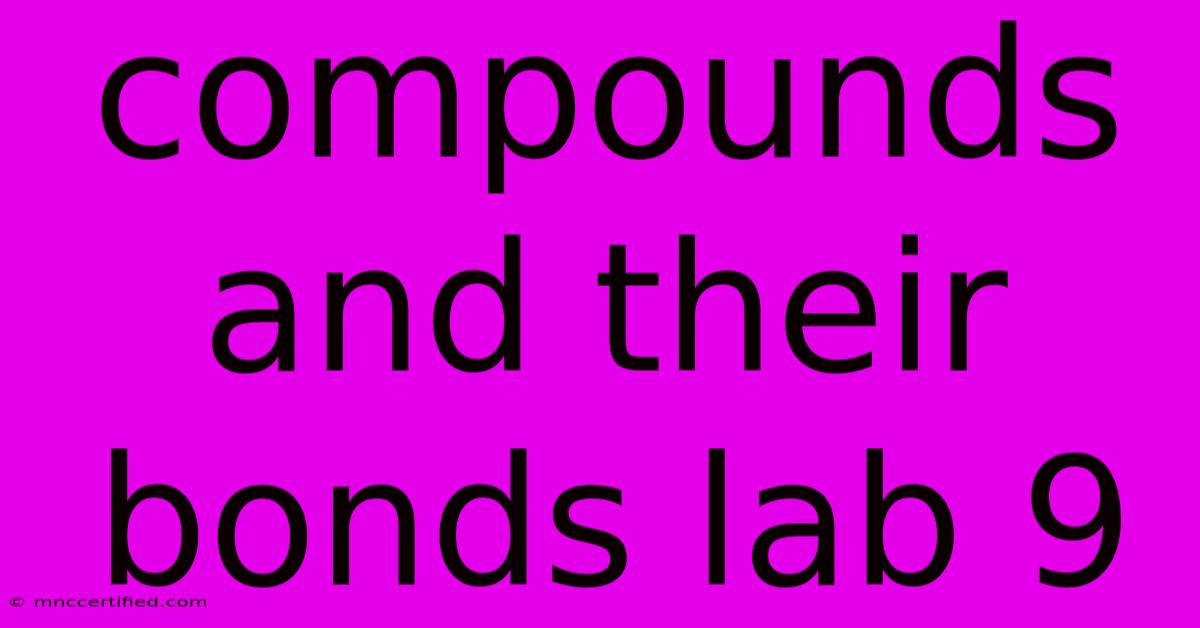Compounds And Their Bonds Lab 9

Table of Contents
Compounds and Their Bonds: Lab 9 – A Comprehensive Guide
This guide provides a detailed walkthrough of a typical "Compounds and Their Bonds" lab (Lab 9), focusing on key concepts, procedures, safety precautions, and data analysis. This comprehensive approach will help you understand the experiment, write a compelling lab report, and improve your understanding of chemical bonding. We'll cover various bond types, including ionic, covalent, and metallic bonds, and explore how these bonds influence the properties of compounds.
Understanding Chemical Bonds
Before diving into the lab procedures, let's review the fundamental types of chemical bonds:
Ionic Bonds
Ionic bonds are formed through the electrostatic attraction between oppositely charged ions. These bonds typically occur between metals (which readily lose electrons) and nonmetals (which readily gain electrons). High melting points and solubility in water are common characteristics of ionic compounds. Examples include NaCl (sodium chloride) and MgO (magnesium oxide).
Covalent Bonds
Covalent bonds involve the sharing of electrons between two nonmetal atoms. This sharing results in a stable molecule. Covalent compounds often have lower melting points than ionic compounds and are less soluble in water. Examples include H₂O (water) and CO₂ (carbon dioxide).
Metallic Bonds
Metallic bonds are formed between metal atoms. The valence electrons are delocalized, meaning they are free to move throughout the metal lattice. This explains the characteristic properties of metals, such as high electrical conductivity and malleability.
Lab 9 Procedures: A Step-by-Step Guide
(Note: This section provides a general outline. Your specific lab procedures might vary. Always refer to your lab manual for precise instructions.)
The "Compounds and Their Bonds" lab typically involves several experiments designed to demonstrate the properties of different types of compounds. These might include:
1. Conductivity Tests: This part will test the ability of different compounds (ionic, covalent, and metallic) to conduct electricity in both solid and dissolved states. This helps differentiate between ionic and covalent compounds based on their ability to conduct electricity when dissolved in water (due to the presence of mobile ions).
2. Melting Point Determination: Determine the melting points of various compounds using a melting point apparatus. Comparing melting points helps distinguish between ionic and covalent compounds, as ionic compounds generally have higher melting points.
3. Solubility Tests: Investigate the solubility of different compounds in water. Observe and record whether the compounds dissolve and the rate of dissolution. This helps categorize compounds based on their polarity and bonding type.
4. Flame Tests (Optional): Perform flame tests on certain metal-containing compounds to observe the characteristic colors produced. This demonstrates the interaction between electrons and energy, further illustrating the properties of ionic compounds.
Safety Precautions: Essential for Lab Success
Laboratory safety is paramount. Always follow these precautions:
- Wear safety goggles: Protect your eyes from chemical splashes.
- Use a lab coat: Protect your clothing from spills.
- Handle chemicals carefully: Avoid direct contact with skin.
- Dispose of waste properly: Follow your instructor's guidelines for waste disposal.
- Report any accidents immediately: Inform your instructor of any incidents.
Data Analysis and Lab Report Writing
After completing the experiments, carefully analyze your data. Your lab report should include:
- Introduction: Briefly explain the concepts of ionic, covalent, and metallic bonds.
- Materials and Methods: Describe the materials used and the procedures followed.
- Results: Present your data in tables and graphs. Include observations from each experiment.
- Discussion: Interpret your results. Explain how your observations support or contradict the theory of chemical bonding. Address any discrepancies or errors.
- Conclusion: Summarize your findings and state your conclusions.
Keywords for SEO Optimization
To improve search engine optimization, incorporate relevant keywords throughout your content, including: chemical bonds, ionic bonds, covalent bonds, metallic bonds, lab report, lab 9, compounds, melting point, conductivity, solubility, safety precautions, data analysis, chemical properties. Use a variety of keyword phrases to ensure natural language flow.
By following these guidelines, you'll be well-prepared to conduct Lab 9 effectively and write a high-quality lab report that showcases your understanding of compounds and their bonds. Remember to always consult your lab manual for specific instructions and safety guidelines.

Thank you for visiting our website wich cover about Compounds And Their Bonds Lab 9. We hope the information provided has been useful to you. Feel free to contact us if you have any questions or need further assistance. See you next time and dont miss to bookmark.
Featured Posts
-
Gaetz Withdraws Trumps Ag Nominee
Nov 22, 2024
-
Premier Capital Investment Group
Nov 22, 2024
-
E On Nexts 14 5m Prepayment Bill Issue
Nov 22, 2024
-
Homeowners Insurance Power Surge
Nov 22, 2024
-
Mexico Citizenship By Investment
Nov 22, 2024